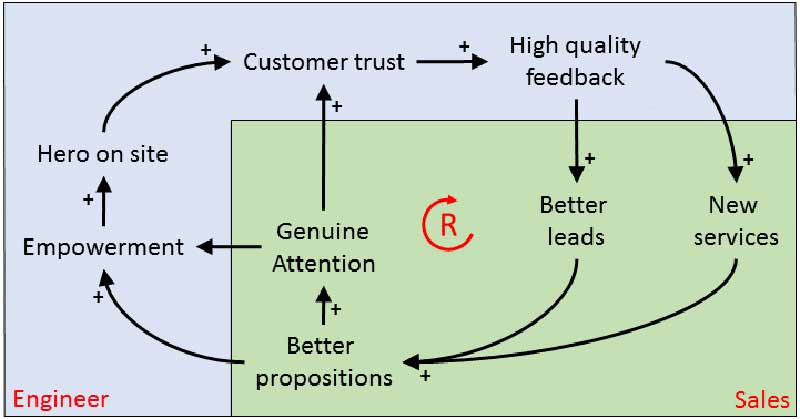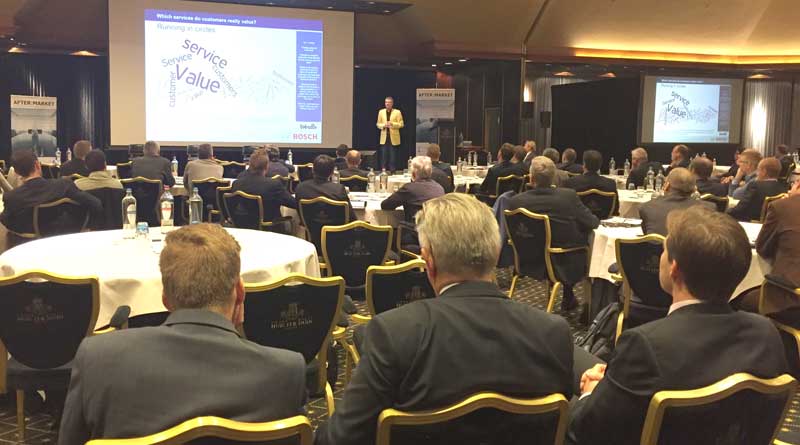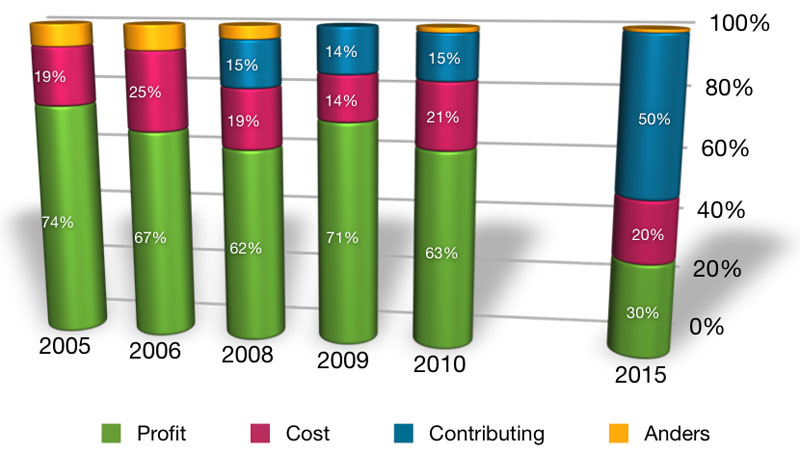When we need light, we buy a bulb. When we need a hole, we buy a drill. It is so engrained in our thinking to own products whilst we actually need the outcome. More and more we see upstart businesses cater to this “new” demand. They sell a product as a service (PAAS). How are you preparing your organisation to sell your product as a service?
“We move water”
At the After:Market 2016 event in Wiesbaden a German manufacturer of pumps introduced his company with the words “we move water”. With those simple words he set the stage for his PAAS business model. Selling the pump is not his goal; it is a means to start an outcome-based discussion with his client. In doing so he enters in a conversation where he truly understands what drives his customer.
“If you make a fantastic long lasting products, how do you earn money when the market is saturated?”
Because the conversation goes beyond the pump, he has created a new business model where he earns money with moving water. The additional benefit is for the environment. Instead of designing your product for repeat sales you will wind down a track where you deliver outcome at a minimal material/ energy footprint.
Transforming legacy business is possible

Understanding the effort it takes to transform a legacy business, University of Cambridge professor Andy Neely asked the panel of the Field Service Summit 2017 in Warwick what successful transformation examples should encourage others to follow suit. Both Boeing and Philips demonstrate you can have best of both worlds. They serve customers in a hybrid model. Via one business unit customers can buy the product in a legacy CAPEX/ OPEX mode. Via another business unit customers can buy the output/ outcome of the product. Depending on his propensity, a customer can choose between a jet engine and a “power by the hour” propulsion solution or a bulb and a “pay per Lux” illumination solution.
“Do you need a bulb or are you in need of light?”
Dialogue inset is a freely edited transcript of VPRO Tegenlicht documentary “don’t own, enjoy” November 8th, 2015 (Dutch). A variant of the message in English can be found here.
Why should you explore PAAS
It may scare corporate executives and sound very blunt but exploring PAAS is a “do or die” message. If you don’t do it, somebody else will. At best it is your current competition and you can see it coming. For the worst, you will face competition from newcomers starting with a clean slate.
Record labels were so focussed on holding to their CD product revenue stream and deliberated so long on legal download options, they were decimated by services like Spotify.
How do you assess your organisation?
“Products are meant to deliver a solution.”
Using a more positive approach: the more you understand how the outcome of your products generates value to your customer the more you establish yourself as long term partner in both a profitable and sustainable way.
Where to start
In the example of Philips Lighting, a small team beyond the radar of product based business model executives designed the “pay per Lux” solution. Upon demonstrated success with a launching customer the new PAAS solution was put in the spotlight.
Setting up a sandbox environment with servitisation minded people is essential, as you will be in for a paradigm shift:
- When you sell Outcome there is no title passage of the Product. This means the product remains on your balance sheet.
- As supplier you will be responsible for and remain in control of all CAPEX and OPEX cost components.
- You need to understand your customer to define a “pay per use” earnings model.
Understanding cost
 In the Philips Lighting dialogue the customer asks for a Design, Build, Finance, Maintain and Operate solution. This DBFMO framework can be used to understand total cost of ownership.
In the Philips Lighting dialogue the customer asks for a Design, Build, Finance, Maintain and Operate solution. This DBFMO framework can be used to understand total cost of ownership.
Design and Build lead to the commissioning of a Product. Maintaining the Product safeguards the Output of the Product. Operating the Output provides an Outcome. The Outcome generates Value.
Maintain and Operate are stated in terms of OPEX. When adding Finance services to your portfolio, you can transpose Design and Build CAPEX into OPEX too.
Design-for-Operate
With PAAS the total cost of ownership shifts from customer to supplier. As a result the supplier is incentivised to throw in all his expertise to continuously optimise product, output and outcome.
In order to make pay per use profitable all cost elements of DBFMO need to be designed in unison. Call it design-for-operate. Where design-for-service supplements design-for-manufacturing, design-for-operate augments the former two.
“Business models based on breaking products should not be accepted”
Pay per use
Where design-for-operate drives towards minimising waste and cost, engineering the right pay per use model determines your revenue. This is where entrepreneurship and partnership kicks in.
Pay per use is a bi-directional handshake between supplier and customer that takes it to the next level compared to a typical sales-purchasing relationship. Instead of a cost/ revenue conversation about products and output your dialogue will evolve into an outcome based profit/ value handshake.
Your customer will help you define the pay per use drivers. If you really understand his business and you are confident in the capabilities of your own organisation to generate outcome that makes your customer succeed, your customer will be inclined to enter into a partnership to make you succeed as well. As a result de pay per use drivers will be fair, sustainable and durable to both parties.
Don’t own, enjoy
Ownership comes with responsibilities. Why should a customer have to carry the risk whilst the supplier is the expert in both understanding and influencing risk. A PAAS model is the ultimate form of “back to core business”. The supplier managed DBFMO, the customer uses the outcome to generate value. In return the customer pays for use.
Does pay per use really work for both parties or do words like partnership, fair and sustainable sound altruistic? The IT industry does give us insight into what is to come. Because SAAS solutions are available for consumers as well, first hand experience is changing our perceptions, attitude and decision-making regarding cost and value.
Published in Field Service News issue #xx (July/August 2017 and website











